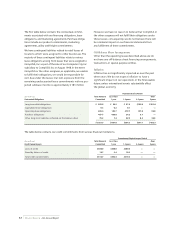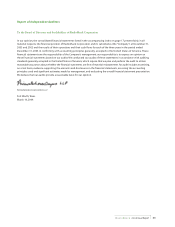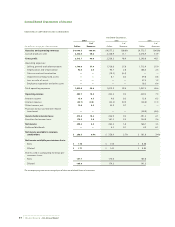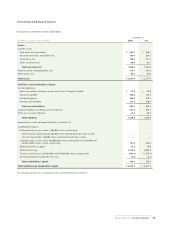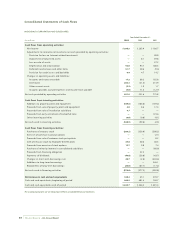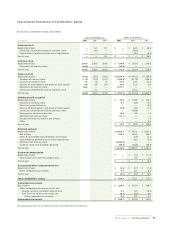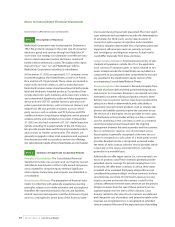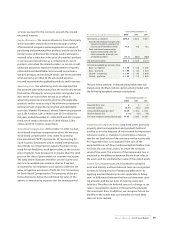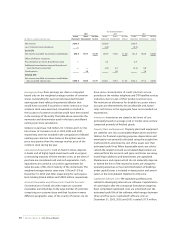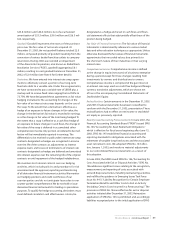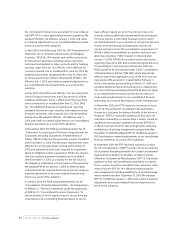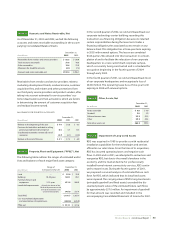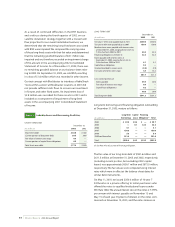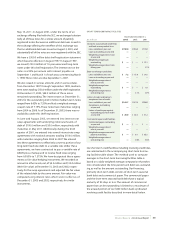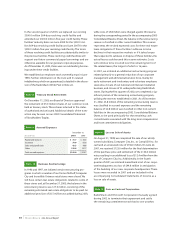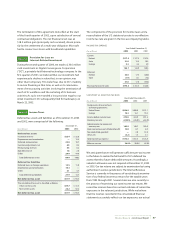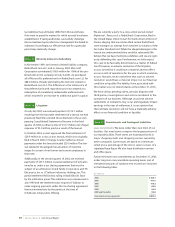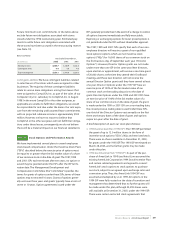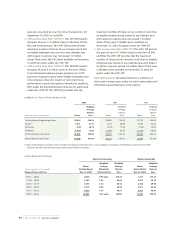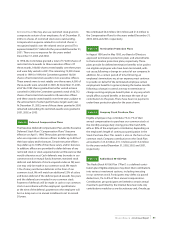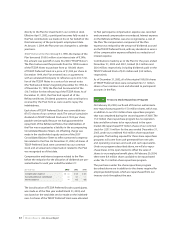Radio Shack 2003 Annual Report Download - page 44
Download and view the complete annual report
Please find page 44 of the 2003 Radio Shack annual report below. You can navigate through the pages in the report by either clicking on the pages listed below, or by using the keyword search tool below to find specific information within the annual report.
RADIOSHACK 2003 Annual Report
42
have sufficient equity at risk for the entity to finance its
activities without additional subordinated financial support.
For those entities, a controlling financial interest cannot
be identified based on an evaluation of voting interests and
may be achieved through arrangements that do not
involve voting interests.The consolidation requirement of
FIN 46 is effective immediately to variable interests in vari-
able interest entities (“VIEs”) created or obtained after
January 31, 2003. FIN 46 also sets forth certain disclosures
regarding interests in VIEs that are deemed significant, even
if consolidation is not required. In December 2003, the
FASB issued FIN 46 (revised December 2003),“Consolidation
of Variable Interest Entities” (FIN 46R), which delayed the
effective date of the application to us of FIN 46 to non-spe-
cial purpose VIEs acquired or created before February 1,
2003, to the interim period ending on March 31, 2004, and
provided additional technical clarifications to implementa-
tion issues.We have determined that FIN 46 does not apply
to our dealer/franchise outlets and we do not expect to
make material adjustments to our consolidated financial
statements as a result of the adoption of this Interpretation.
In November 2002, the EITF reached a consensus on Issue
No.02-16,“Accounting for Consideration Received from a
Vendor by a Customer (Including a Reseller of the Vendor’s
Products).”EITF 02-16 provides guidance on how cash con-
sideration received by a customer from a vendor should be
classified in the customer’s statement of income.EITF 02-16
is effective prospectively for new arrangements, including
modifications of existing arrangements,entered into after
December 31, 2002.We adopted EITF 02-16 effective January 1,
2003, and made no material adjustments to our consolidated
financial statements as a result of this adoption.
In November 2003, the EITF reached a consensus on Issue
No. 03-10,“Application of EITF Issue No. 02-16,‘Accounting
by a Customer (Including a Reseller) for Certain Consideration
Received from a Vendor,’ by Resellers to Sales Incentives
Offered to Consumers by Manufacturers.”EITF 03-10 provides
guidance on how cash consideration received by a customer
from a vendor should be classified in the customer’s state-
ment of income.EITF 03-10 is effective prospectively for
new arrangements,including modification of existing arrange-
ments,entered into after December 31, 2003.We adopted
EITF 03-10 effective January 1, 2004, and made no material
adjustments to our consolidated financial statements as a
result of this adoption.
No.146 should continue to be accounted for in accordance
with EITF 94-3 or other applicable preexisting guidance.We
adopted SFAS No.146 effective January 1, 2003, and made
no material adjustments to our consolidated financial state-
ments as a result of this adoption.
In April 2003, the FASB issued SFAS No. 149,“Amendment of
Statement 133 on Derivative Instruments and Hedging
Activities.” SFAS No. 149 amends and clarifies accounting
for derivative instruments, including certain derivative
instruments embedded in other contracts, and for hedging
activities under SFAS No. 133. SFAS No. 149 is effective for
contracts entered into or modified after June 30, 2003, for
hedging relationships designated after June 30, 2003, and
to certain preexisting contracts.We adopted SFAS No. 149
effective July 1, 2003, and made no material adjustments to
our consolidated financial statements as a result of this
adoption.
In May 2003, the FASB issued SFAS No. 150,“Accounting for
Certain Financial Instruments with Characteristics of Both
Liabilities and Equity,”which is effective for financial instru-
ments entered into or modified after May 31, 2003. SFAS
No.150 establishes financial accounting and reporting
standards for how an issuer classifies and measures certain
financial instruments with characteristics of both liabilities
and equities.We adopted SFAS No. 150 effective June 1,
2003, and made no material adjustments to our consolidated
financial statements as a result of this adoption.
In November 2002, the FASB issued Interpretation No.45,
“Guarantor’s Accounting and Disclosure Requirements for
Guarantees, Including Guarantees of Indebtedness of
Others.” FIN 45 is effective for guarantees issued or modified
after December 31, 2002.The disclosure requirements were
effective for certain guarantees existing at December 31,
2002, and expand the disclosures required by a guarantor
about its obligations under a guarantee. FIN 45 also requires
that we recognize guarantees entered into or modified
after December 31, 2002, as a liability for the fair value of
the obligation undertaken in the issuance of the guarantee.
We adopted FIN 45 on January 1, 2003, its effective date,
and, aside from the required disclosure provisions, made no
material adjustments to our consolidated financial state-
ments as a result of this adoption.
In January 2003, the FASB issued Interpretation No. 46,
“Consolidation of Variable Interest Entities – An Interpretation
of ARB No.51.” FIN 46 is intended to clarify the application
of ARB No. 51,“Consolidated Financial Statements,” to
certain entities in which equity investors do not have the
characteristics of a controlling financial interest or do not


